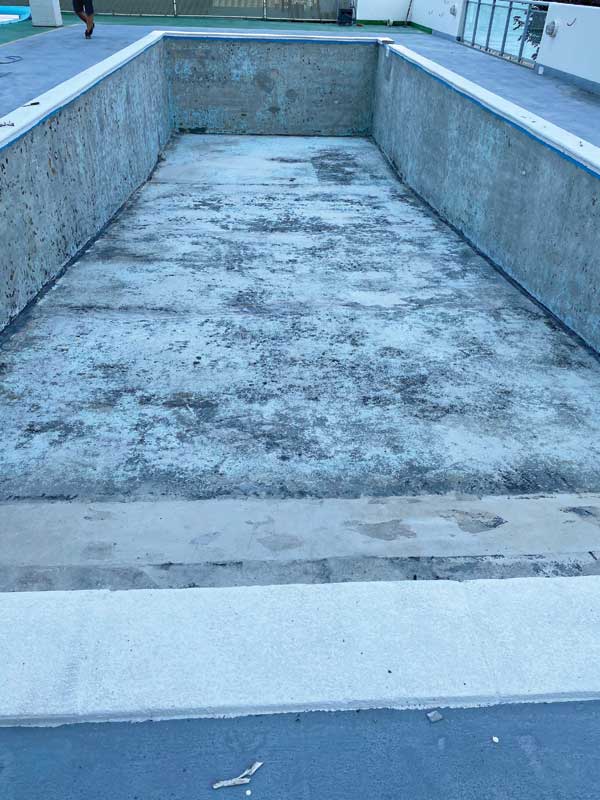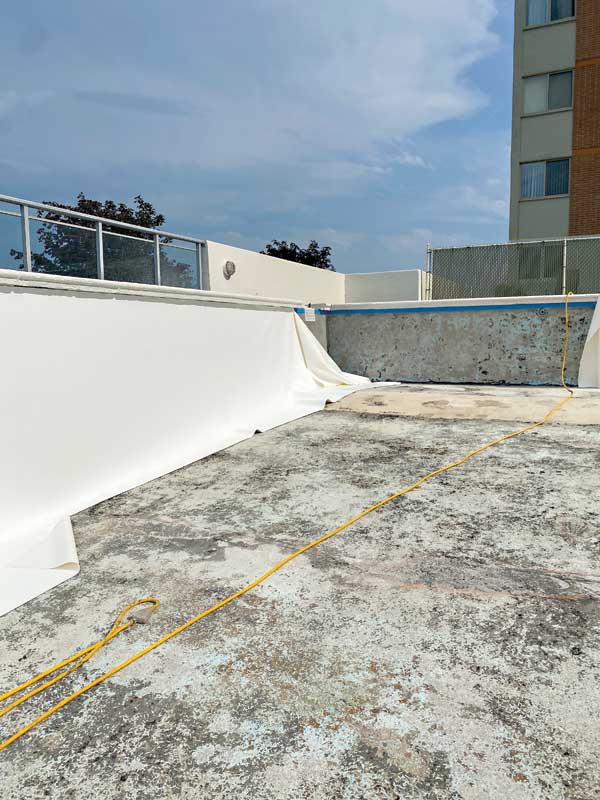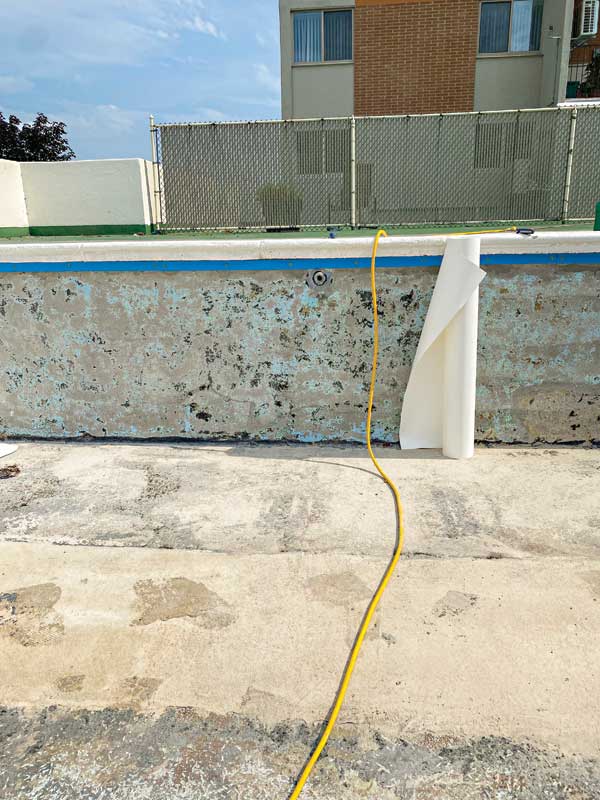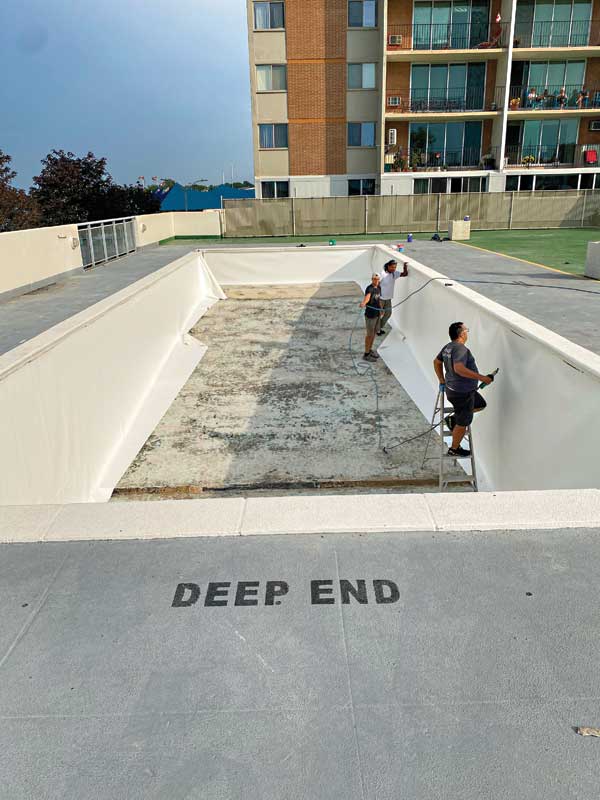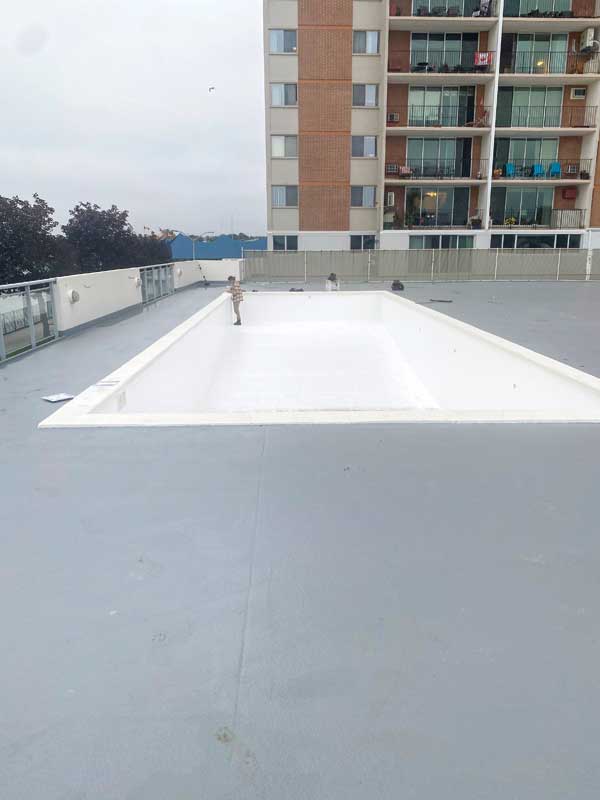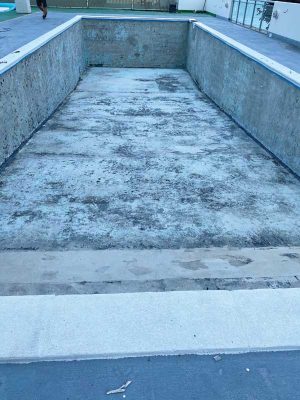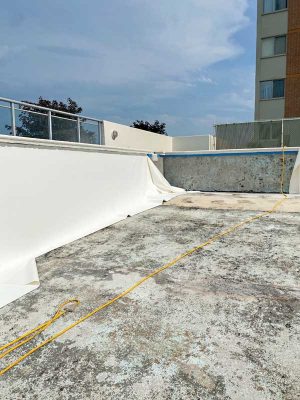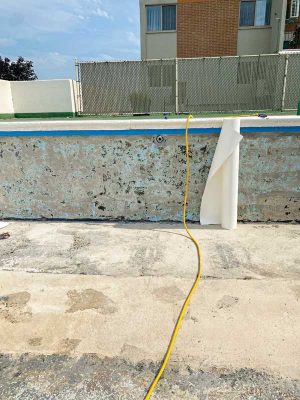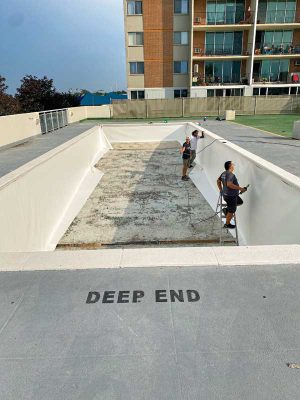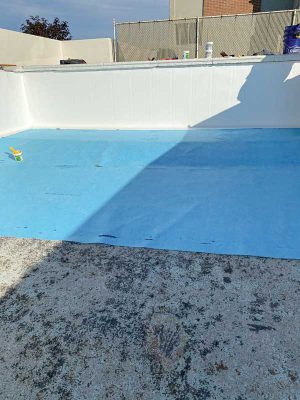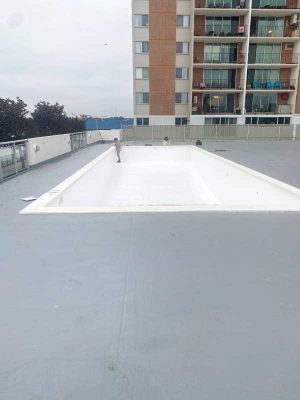Pool company finds a complementary product to its existing renovation services
by arslan_ahmed | December 15, 2022 5:47 pm
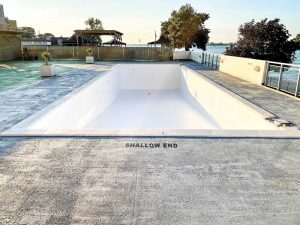 [1]
[1]By Matthew Sands
Ontario Pool Coatings Inc. is based out of London, Ontario, and services all southern parts of the province—from the Greater Toronto Area to Windsor. For the last seven years, the team has become the go-to experts for renovation projects using epoxy resin, epoxy paint, thermoplastic coatings, and complete concrete renovations on both commercial and residential pools.
This year, Darren Borland, president of the company, added polyvinyl chloride (PVC) membranes to its range of services; he decided some projects are best renovated with a membrane. In the company’s first year of offering this product, it has completed two commercial jobs and one residential pool using this waterproofing system. In these three projects, PVC membrane was the ideal choice and Borland provides insight as to why.
Elevated condominium pool
The condominium board of a complex had been calling around for a solution to its leaking pool for some time. Located on the banks of the St. Clair River, this condominium pool sits directly above a parking structure, where a leak visibly presented itself. This issue required a long-term waterproofing repair, and a PVC membrane would provide the optimum solution for the problem at hand.
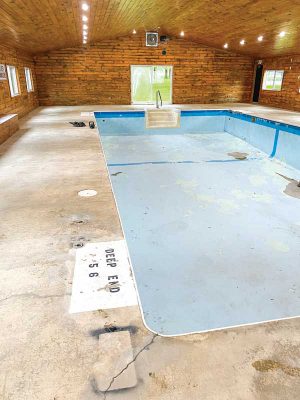 [2]
[2]When Borland and his team inspected the pool, they were confronted with a 6.1 x 18.3 m (20 x 60 ft) concrete pool with a traditional, 30 mil (0.0300 in.) vinyl liner. The liner was not well-suited for this commercial application because of the higher bather loads and increased sanitization levels in the water, causing the liner to fail. Although the PVC membrane is not the least expensive option, in the case of this condominium board, it was looking for a long-term solution and were tired of dealing with the maintenance and leaks in this pool.
The installation process is fairly straightforward. Before installing the PVC membrane, crews prepare the surface, which can also include repairs. Most pools require a day or less for preparation, but if a pool is in particularly bad shape, a service professional may need up to a week to patch the pool, fix returns, cracks, and other issues.
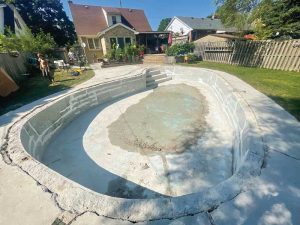 [3]
[3]“It was fairly easy to sell them on the savings because of all the time, money, and hassle they had been dealing with over the years, as part of pool maintenance,” says Borland.
Once the team removed the old vinyl liner, they worked on preparing the surface for the new PVC membrane.
“There were so many layers of paint on that concrete pool,” says Borland. “Rubber paint, epoxy paint, it was like 60 years of paint.”
The team spent several days preparing the surface, smoothing it out, and making repairs before applying a glued felt backing. Then, they installed a PVC membrane, which was custom welded on-site. The team also ran new plumbing to ensure the pool functioned as new when the renovation was complete.
“The PVC membrane is a complete waterproofing membrane that is guaranteed for at least 10 years, and it is very forgiving. If the concrete shell shifts or cracks, the membrane will hold water regardless,” says Borland. “Clients want something long-lasting that isn’t going to leak so they appreciate the additional insurance the PVC membrane provides.”
Indoor campground pool
This was another example of a pool proving to be a huge maintenance headache for a local camp.
“The pool had some sort of rubber surface which was chalking in a way that when you rubbed it with your hand, you would get covered with a white film,” says Borland. “It was painted so many times I don’t even know what the initial surface was.”
After starting the project, Borland’s team discovered there was a high-water table in the area.
“We didn’t know it at the time, but clearly the high-water table was responsible for a lot of the pool’s damage,” he says.
Similar to the condominium project, this pool required a lot of preparation. However, knowing they were installing a PVC membrane on the pool, a long-lasting, watertight, waterproofing solution was guaranteed.
Once the surface was prepared, the team installed a felt lining along the floor and walls of the pool structure. The material, also referred to as geotextile, acts as an anti-bacterial to avoid bacteria proliferation behind the membrane to extend the life of the product. As a side benefit, the felt lining makes the floor more comfortable to stand on. This is especially beneficial for bathers using the pool for water conditioning, therapy, or aerobics.
After the geotextile is installed, workers roll out 1.8 m (6 ft) wide strips of the PVC membrane and heat-weld them together on-site for a smooth finish. They also cut, fit, and weld any steps, beach entries, safety ledges, etc.
The PVC membrane installed on the campground pool features a slip-resistant, embossed surface, which is generally used on steps, in shallow areas, and beach entries. Black PVC material was also used to create racing lanes, transitions, and depth markers.
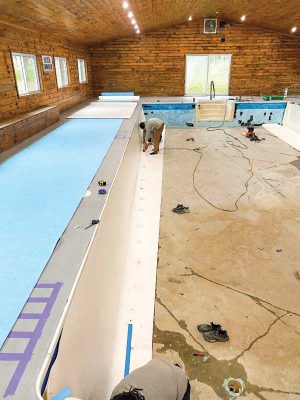 [4]
[4]“The client was thrilled to know they no longer have to work on the pool surface every year, as they were doing so previously,” says Borland. “Commercial pool operators understand the value of not having to constantly maintain the pool surface every year, as it saves time and money. Further, a better pool surface is appreciated by residents, campers, and maintenance staff.”
Residential pool
This pool was an extreme task. For this renovation project, one of the only ways the customer could fix their pool was to use a PVC membrane or simply fill it in.
When Borland and his team got into the crack repair, what they had learned was hairline cracks hide more cracks within the cracks.
“We originally planned and quoted a standard paint job, but once we got started, we realized there were only two options for the client,” says Borland. “We discovered that, although the structure of the pool wasn’t compromised, the cracks were so severe, it would have never held water.”
Borland told the client they would have to waive all warranties if they wanted to continue repairs and repainting, or they could have a PVC membrane installed with guarantees from the company.
“What basically happened was, contractors were filling the cracks for many years, and there were 61 m (200 ft) of cracks; therefore, to give the client the guarantee that painting their pool would fix the problem was impossible,” says Borland. “We still fixed the cracks, but because we were using a PVC membrane, we knew if the cracks opened up again, there would be no harm, and the pool wouldn’t lose water.”
Borland and his team have been seeing more pools experiencing this type of cracking problem.
“In areas where new condos, big buildings, and other major construction is occurring, we’ve started to see ground disturbance and drainage concerns in many of our pool renovation projects,” says Borland. “In this case, the home was close to a new hospital, so there was ground movement, new water movement, and water tables rose. It’s not the homeowner’s fault their pool suffers damage because the water table in the area changed.”
A new coating option
The company finds PVC membrane to be a complementary product to its already existing service offerings.
“It’s a new addition to our toolbox,” says Borland. “With traditional pool coating renovation projects, we tell the client if their pool has a good structure, we can provide a good finish. With PVC membrane, we can take on renovation projects that are riskier. We can install it on pools that are not perfectly built, as the membrane is more forgiving to movement and cracking and will still hold water.”
For Borland, adding a PVC membrane system encourages the company to take on projects they were not able to perform previously; further allowing him to expand his business to a larger number of potential clients.
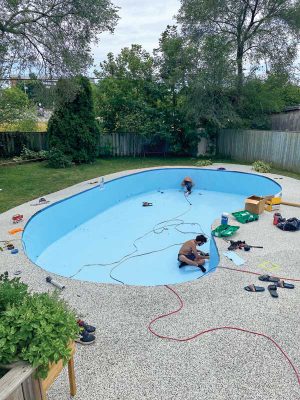 [5]
[5]The awareness surrounding PVC membranes is on the rise, especially among commercial aquatic facilities. In fact, many architects and aquatic consultants are starting to request this pool finish option in high-rise structures or anywhere waterproofing must be guaranteed. For those looking to expand their business, PVC membranes might be the ideal fit. S
For the indoor camp pool, a high-water table in the area was responsible
for its many maintenance issues.
Before a polyvinyl chloride (PVC) membrane was installed, the residential kidney bean shaped pool had hairline cracks, which hid more cracks within the cracks.
Once the surface was prepared, workers rolled out 1.8 m (6 ft) wide strips of the PVC membrane and heat-weld them together on-site for a smooth finish.
The residential pool with a new light blue membrane and decking treatment.
Matthew Sands is a sales engineer for Renolit, a manufacturer of plastics-based construction products, and weld-in-place, reinforced PVC membrane systems for swimming pools and decks, with U.S. headquarters in LaPorte, Indiana. He has more than a decade of experience in the construction renovation sector of the company.
Elevating expectations with a PVC liner
 Author
Author
Matthew Sands is a sales engineer for Renolit, a manufacturer of plastics-based construction products, and weld-in-place, reinforced PVC membrane systems for swimming pools and decks, with U.S. headquarters in LaPorte, Indiana. He has more than a decade of experience in the construction renovation sector of the company.
- [Image]: https://www.poolspamarketing.com/wp-content/uploads/2022/12/OntarioCoating-elevated-condo-pool-with-newly-finished-PVCMembrane-lining-MG_3983-copy.jpg
- [Image]: https://www.poolspamarketing.com/wp-content/uploads/2022/12/ontario-coatings-camp-pool-BEFORE-lining-with-PVCMembrane-MG_4448-2-copy.jpg
- [Image]: https://www.poolspamarketing.com/wp-content/uploads/2022/12/Ontario-Coatings-residential-pool-BEFORE-cracks-kidney-shape-IMG_6804.jpg
- [Image]: https://www.poolspamarketing.com/wp-content/uploads/2022/12/ontario-coatings-rolled-out-felt-and-membrane-on-deck-while-welding-PVC-Membrane-in-place-IMG_4581-copy.jpg
- [Image]: https://www.poolspamarketing.com/wp-content/uploads/2022/12/Ontario-Coatings-new-light-blue-membrane-and-new-decking-treatment-IMG_6940.jpg
Source URL: https://www.poolspamarketing.com/trade/pool-company-finds-a-complementary-product-to-its-existing-renovation-services/
